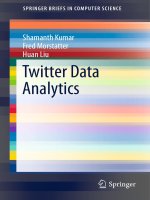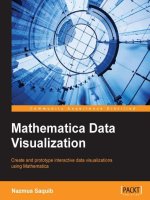IT training fashioning data khotailieu
Bạn đang xem bản rút gọn của tài liệu. Xem và tải ngay bản đầy đủ của tài liệu tại đây (3.43 MB, 48 trang )
Make Data Work
strataconf.com
Presented by O’Reilly and Cloudera,
Strata + Hadoop World is where
cutting-edge data science and new
business fundamentals intersect—
and merge.
n
n
n
Learn business applications of
data technologies
Develop new skills through
trainings and in-depth tutorials
Connect with an international
community of thousands who
work with data
Job # 15420
Fashioning Data:
A 2015 Update
Data Innovations from
the Fashion Industry
Liza Kindred
with Julie Steele
Fashioning Data: A 2015 Update
by Liza Kindred with Julie Steele
Copyright © 2015 O’Reilly Media, Inc. All rights reserved. All images © Paige Hogan
for Third Wave Fashion.
Printed in the United States of America.
Published by O’Reilly Media, Inc., 1005 Gravenstein Highway North, Sebastopol, CA
95472.
O’Reilly books may be purchased for educational, business, or sales promotional use.
Online editions are also available for most titles (). For
more information, contact our corporate/institutional sales department:
800-998-9938 or
Editor: Shannon Cutt
Production Editor: Dan Fauxsmith
September 2015:
Interior Designer: David Futato
Cover Designer: Randy Comer
Illustrator: Rebecca Demarest
First Edition
Revision History for the First Edition
2015-09-02: First Release
The O’Reilly logo is a registered trademark of O’Reilly Media, Inc. Fashioning Data:
A 2015 Update, the cover image, and related trade dress are trademarks of O’Reilly
Media, Inc.
While the publisher and the authors have used good faith efforts to ensure that the
information and instructions contained in this work are accurate, the publisher and
the authors disclaim all responsibility for errors or omissions, including without
limitation responsibility for damages resulting from the use of or reliance on this
work. Use of the information and instructions contained in this work is at your own
risk. If any code samples or other technology this work contains or describes is sub‐
ject to open source licenses or the intellectual property rights of others, it is your
responsibility to ensure that your use thereof complies with such licenses and/or
rights.
978-1-491-93110-3
[LSI]
In order to be irreplaceable one must always be different.
—Coco Chanel
Vain trifles as they seem, clothes have, they say,
more important offices than to merely keep us warm.
They change our view of the world
and the world’s view of us.
—Virginia Woolf
Table of Contents
Fashion: What Has It Done for You Lately?. . . . . . . . . . . . . . . . . . . . . . . 1
What’s Inside
2
Trends in Fashion Data. . . . . . . . . . . . . . . . . . . . . . . . . . . . . . . . . . . . . . . 3
Irrational Fashion
Fashion’s Data Lifecycle
Fashion’s Data Startups
Preferences In, Fashion Out
3
5
6
9
Addressing the Challenges. . . . . . . . . . . . . . . . . . . . . . . . . . . . . . . . . . . 13
The Only Constant Is Change
Geography as a Shorthand for Style
Humans, Meet Machines
Natural Language Processing
All About that Algorithm
Curation, Discovery, and Inspiration—versus Algorithms
Visual Search: Oh No, You Didn’t
Mining Menswear
14
15
16
18
21
25
26
28
Fashion Forward. . . . . . . . . . . . . . . . . . . . . . . . . . . . . . . . . . . . . . . . . . . 31
Online Meets Offline
Wearables and Big Data
Privacy, Please
31
32
33
What’s Next?. . . . . . . . . . . . . . . . . . . . . . . . . . . . . . . . . . . . . . . . . . . . . . . 35
The Big Wishes
36
Conclusion. . . . . . . . . . . . . . . . . . . . . . . . . . . . . . . . . . . . . . . . . . . . . . . . 39
vii
Fashion: What Has It
Done for You Lately?
When it comes to big data, maybe a lot.
Fashion is an industry that struggles for respect—despite its enor‐
mous size globally, it is often viewed as frivolous or unnecessary.
And it’s true—fashion can be spectacularly silly and wildly extrane‐
ous. But somewhere between the glitzy, million-dollar runway
shows and the ever-shifting hemlines, a very big business can be
found. One industry profile of the global textiles, apparel, and
luxury goods market reported that fashion had total revenues of
$3.05 trillion in 2011, and is projected to create $3.75 trillion in rev‐
enues in 2016.
The majority of these purchases are made not out of necessity, but
out of a desire for self-expression and identity, two remarkably diffi‐
cult things to quantify and define. Yet somehow myriad different
businesses are finding clever ways to use big data to do just that—to
turn fashion into bits and bytes, as much as threads and buttons.
In these shrewd applications of big data are lessons for industries of
all types. From the lessons of a complex lifecycle to the methods of
new startups, and from merging humanity with machine learning to
improving visual search, the information in this report will change
the way you think about the applications of big data.
So how can we turn the emotional aspects of fashion into actionable
data? What can be learned from the fashion industry that differs
from what is already familiar to the Strata audience? How can
humans and machines work together to help solve problems that are
1
at once sentimental and pragmatic? We aim to address these ques‐
tions in this report.
What’s Inside
This updated report takes a look at the important ways that fashion
has used big data to address the complications of the industry, the
importance of algorithms, and one of the biggest technical chal‐
lenges in fashion and beyond: visual search. We also explore the
complexities of natural language processing and its implications
across industries.
Don’t like to shop? Don’t worry. This report encompasses the
essence of how fashion brands and startups are using data to drive
big sales—and how you can, too. It will also become clear that there
is an overlap between fashion and other, more technical industries—
relating to everything from using algorithms to relying on natural
language processing. In addition, we can learn lessons from the
most innovative fashion start-ups that apply well beyond the fashion
industry.
One of the things that fashion has always done very well is to have
two-way conversations with customers. “Most companies—Google,
Yahoo!, Netflix—use what they call inferred attributes: they guess.
We don’t guess, we ask,” says Eric Colson, who spent six years at
Netflix before becoming the Chief Algorithms Officer at Stitch Fix, a
personalized online shopping and styling service for women. This is
an attitude that most other industries would do well to incorporate.
2
|
Fashion: What Has It Done for You Lately?
Trends in Fashion Data
In difficult times,
fashion is always outrageous.
—Elsa Schiaparelli
Part of the challenge in fashion is something that every industry
faces: “fitting the world into rectangles,” a phrase Columbia Univer‐
sity professor Chris Wiggins once used to describe the process of
translating everyday experiences into spreadsheets.
However, fashion’s rectangles are the kinds that change color, shape,
and size every season—and even much more frequently these days.
That rapidly shifting landscape offers big opportunities, but also
comes with a unique set of challenges.
We’ll start by looking at some of what makes fashion’s relationship to
big data unique: the emotional and unpredictable aspects of the
industry; the lifecycle of the industry and how data is playing into
every part of that cycle; the entire crop of new startups addressing
big data in myriad ways; and the unique kinds of inputs and outputs
that are making the relationship work.
Irrational Fashion
Fashion is instant language.
—Miuccia Prada
As we mentioned, fashion is not just about clothing; it’s also about
identity and expression. Even the most rational among us make
decisions about how to clothe and accessorize ourselves based on
irrational factors. We don’t “need” a new pair of pants because the
old ones don’t function as pants anymore; we “need” them because
3
we don’t like what the old pair is saying about us (that we’re dirty, or
careless, or behind the times).
Still, it’s possible—and necessary—to find ways to correlate data
with that emotion. Shawn Davis is currently Senior Director of
Advanced Retail Analytics at Nike, and previously served as VP of
Analytics at ModCloth, an online retailer for indie clothing, accesso‐
ries, and decor. Shawn told us about his experience at ModCloth:
“We’d be regularly sitting in meetings with our merchandising team,
and listening to them describe why they think something is hot, or
why they think the customer is going to love a particular product,
and then trying to translate that into something that we could sur‐
face analytically in the data.”
Lorraine Sanders, a San Francisco-based journalist who’s written
extensively about the intersection of fashion and tech, and is the
host of the “Spirit of 608” podcast, puts it this way: “We’re in the
middle of a time when big data is becoming an important factor in
just about every industry that deals with human behavior, in order
to generate revenue. It’s happening because, frankly, we’re just hit‐
ting that time in history where the ability to collect data is becoming
widespread and, in many ways, democratized.”
Lorraine goes on to add that, “in a lot of ways, everyone everywhere
can collect big data. It’s the question of what to do with it that’s the
interesting part. With fashion, the data collected from consumer
interactions, engagement, and reactions to products has the poten‐
tial to add a ton of value in helping brands hone in on what’s going
to sell and become more efficient at getting the products they decide
to invest in and produce to the exact right people, at the exact right
time.”
As Lucie Greene, Worldwide Director of The Innovation Group at J.
Walter Thompson put it, “Fashion is about newness and novelty. We
see something and feel compelled to buy it.” Studies claim that 90%
of all purchasing decisions are made subconsciously, and that those
decisions are completed within 2.5 seconds. We buy products, espe‐
cially fashion goods, based on having our emotions evoked in one
way or another. The challenge of data is to find ways to understand,
quantify, and use that emotion in a way that both serves customers’
needs and drives sales.
4
|
Trends in Fashion Data
Fashion’s Data Lifecycle
Another unique aspect of the fashion industry is what is colloquially
referred to as the “fashion cycle”—the time it takes to get a garment
from idea, to runway, to factory, to store. What’s happened recently
in fashion is that consumers are an integral part of the full fashion
cycle—before the fashion is even made, we see a range of consumer
engagement—from designers asking for consumer votes on sleeve
lengths, to brands holding contests for user-generated designs, and
high-fashion brands taking consumer orders based only on samples
shown on the runway. This engagement continues through the sales
cycle all the way through post-sales data opportunities, such as the
proliferation of online “haul” videos (consumer-recorded videos of
recently purchased items) and outfit-based social media posts.
In addition to companies that are finding clever ways to use big data
throughout the fashion cycle, a growing number are starting to use
data to circumvent the traditional data cycle entirely.
Large companies like IBM and SAP and startups like fashion data
analysis company Trendalytics are starting to tap social sentiment
analysis (often correlated with historic demand) to more accurately
predict trends—and specifically to identify when those trends are
likely to begin and—also crucially—when they might end. Compa‐
Fashion’s Data Lifecycle
|
5
nies such as New York-based Moda Operandi, London-based
Wowcracy, and Hong Kong-based LuxTNT offer customers the abil‐
ity to pre-order fashions directly from the runways, instead of wait‐
ing up to six months to buy goods when they hit stores.
Regardless of whether they are trying to supplement or circumvent
traditional cycles, fashion brands make copious use of different
types of data during the design, manufacture, and sale of goods.
Fashion’s Data Startups
When we published the first edition of this report in Fall 2014, we
noted nine different fashion-tech startups that focused on big data.
In the time since, the space has expanded rapidly, further proof of
big data’s importance to the fashion industry. Here are the different
types of companies that are populating fashion’s big data world.
Social Media and Influencer Analytics
Influencer marketing is big business in fashion, driving millions of
hits for brands that partner with top bloggers. On top of that, social
media, especially visually focused platforms, has been absolutely
explosive for fashion—an industry built on knowing the “right” per‐
son and wearing the “right” thing.
CURALATE
An analytics platform that is a darling of the fashion world.
TRIBE DYNAMICS
A platform for fashion and lifestyle brands to track and analyze
complex influencer programs.
D’MARIE
Connects talent agencies and designers with fashion bloggers
that fit their needs.
FOHR CARD
A platform that gives brands access to verified social media stats
of influencers.
Pre-Order
As the relationship between brands and shoppers becomes more
symbiotic, a slew of pre-ordering platforms has opened up, circum‐
6
| Trends in Fashion Data
venting the traditional fashion cycle in a way that can benefit every‐
one.
WOWCRACY
A platform for independent designers to buy and sell goods as
pre-orders.
MODA OPERANDI
Sells luxury fashions on pre-order straight from the runway.
LUXTNT
Asia’s first luxury pre-order platform.
NINETEENTH AMENDMENT
A platform for connecting emerging designers with customers
that also manufactures the goods on their behalf.
Buying Platforms
It truly wasn’t that long ago when buyers “wrote” wholesale orders,
they really wrote them—on paper. A new class of startups is provid‐
ing not only digital ordering capabilities, but all of the big-data tools
needed for buyers and merchandisers to make informed product
and assortment decisions.
JOOR ACCESS
A global wholesale marketplace for hundreds of major brands.
FASHION GPS
Tracks and analyzes samples, images, digital assets, and event
attendance. Closely aligned with NY Fashion Weeks.
MODALYST
A buying platform for connecting independent designers with
small retailers.
Buying Tools
This new crop of high-tech, big-data companies is providing brands
with in-depth analysis of the massively differentiated product
assortments, constantly shifting trends, and rapidly shifting social
sentiment that they are grappling with.
TRENDALYTICS
A visual analytics platform for predicting consumer demand.
Fashion’s Data Startups
|
7
EDITD
A big data tool for fashion designers, merchandisers, and buyers
that quantifies trends in real time by analyzing data from retail,
social, and product metrics.
WGSN INSTOCK
A retail analytics platform from the well-respected global trendforecasting company that uses the same taxonomy crossplatform.
Consumer Facing
Here’s one of the things that fashion companies do well: if they want
to know how consumers are thinking or feeling, they just ask. The
direct dialogue is one of the smartest things that fashion does; these
startups make it easier by providing this data collection and analysis
as a service.
POSHLY
Beauty analytics company that utilizes quizzes and contests to
gather in-depth data for brands.
RANK & STYLE
Algorithm-driven Top 10 lists for fashion and beauty, harness‐
ing user reviews, editorial recommendations, bestsellers lists,
and other buzz.
CLOSETSPACE
A closet-data-tracking platform that gathers data and insights
for brands.
Customer Marketing and Management
When consumers make emotional decisions and have extremely
nuanced fashion needs—due to weather or occasion or selfexpression—highly targeted and segmented information can pro‐
vide the best service possible, and the highest chance for a sale.
These are just a couple of the startups who are focusing on highlytargeted marketing.
CUSTORA
Predictive analytics platform for ecommerce customer acquisi‐
tion, retention, and segmentation.
8
|
Trends in Fashion Data
DATAPOP
An advertising analytics platform that focuses on highly targe‐
ted messages delivered at scale.
Sales Data
Going beyond the typical points of data collection, and diving
deeper into things like trending products and location-based prefer‐
ences, these companies are using sales data to drive deeper engage‐
ment and higher purchase rates.
42
Tracks POS information, product, location, and customer data
to provide insights.
INSPARQ
Trending products feeds, ads, and modules; social sharing tools
and tracking.
Preferences In, Fashion Out
Many fashion brands use the same software and tools as other large
companies—especially other large retail companies. However, there
are some ways that fashion companies gather and use data that are
unique, and they have some unique inputs and outputs as well.
Many fashion brands and companies have mastered the idea of giveand-take conversations with customers. Lorraine Sanders, the fash‐
ion tech journalist, told us that, “Fashion does a really good job of
engaging its audience in a two-way conversation, and that the twoway conversation that takes place can only make the big data collec‐
ted from it richer and more meaningful.”
One popular data-collection technique in fashion, for example, is
the use of “style quizzes” that give consumers fashion advice or a
curated selection of products in exchange for answering questions
about their preferences (for example, see Refinery 29). In fact, it’s
become almost par for the course that fashion brands offer some
kind of way for customers to filter products based on their style of
product preferences.
“Styles” are particularly hard to quantify, as we’ll outline in the sec‐
tion on natural language processing. While machines don’t necessar‐
ily know the nuanced differences between “Boho-chic” and “EditorPreferences In, Fashion Out
|
9
off-duty” styles, the consumer taking the quiz will have very specific
ideas about whether or not they want to see a fringed bag, for exam‐
ple, in the search results.
Therefore, a variety of types of data collection are imperative in
fashion.
Types of Input
Types of Output
Q&A/Style quizzes
Style types
Social media “shares” and “likes”
Color and silhouette preferences
Private clubs and loyalty cards
Aversion or attraction trends
Pre-ordering and ordering directly off the runway
Brand loyalty
In-store sensors; beacons; RFID
Purchase intent
10
| Trends in Fashion Data
Figure 2-1. A results page from a fashion quiz on the website
Refinery 29
Preferences In, Fashion Out
|
11
Addressing the Challenges
If you aren’t in over your head,
how do you know how tall you are?
—T.S. Eliot
The fashion industry has some unique challenges, which we’ll
address in this section. At the same time, some of the challenges the
fashion industry faces will be very familiar to those in any industry.
Topics we’ll explore in this section include the unique pace of supply
and demand, the use of algorithms and natural language processing,
the potential (and importance) of visual search in a highly visual
market, and what’s new with using data in menswear.
First, we’ll explore the rapid pace of change in the fashion industry
—demand for new products happens 8–20 times faster than in con‐
sumer electronics. For instance, consumers these days replace their
mobile phones on average once every 30 months, while they shop
for clothing as often as twice per month. Then, we’ll look at geogra‐
phy, and how it does—and does not—affect demand.
Even when working with hard data, it’s important to let the softer
side of humanity shine through. We’ll look at how companies are
finding ways for humans and machines to work together success‐
fully, as well as explore the challenges and benefits of focusing on
natural language processing.
Algorithms are an integral part of many fashion businesses today,
and we’ll look at companies that are implementing algorithms in
some new and interesting ways. Fashion is emotional, though, and
so it’s also worth comparing the use of algorithms to the continued
use of curation and discovery tools.
13
Visual search is a huge opportunity in fashion—one that many are
trying to tackle but where few are making progress. Still, it’s a mas‐
sive untapped opportunity, so we’ll explore the various approaches
and levels of success with visual search.
We’ll also look at why analyzing big data has become a popular
method for tackling the quickly growing menswear industry.
Let’s dive in.
The Only Constant Is Change
It may be cliché, but fashion really does change constantly. The hot‐
test colors, the newest silhouettes, and the latest “must have”—they
are all in a continuous state of upheaval, by design.
For instance, the color-forecasting company Pantone announces
their “Color of the Year” annually (this year it’s Marsala—and yes, it
is roughly the color of red wine), but they also release dozens of
“official colors” for many industries each season. One key way to
inspire consumers to buy new jeans, for example, is to manufacture
them in the “newest” colors.
Like consumer electronics, fashion trends are designed to become
obsolete and turn over very quickly. But whereas even the latest
mobile phone or new laptop is usually good for at least a couple of
years, clothing can go out of style in a season. Trying to do market
analysis, design, prototyping, manufacturing, customer engagement,
and returns/feedback at that kind of breakneck pace is dizzying.
Until recently, fashion trends were conceived by designers (with the
help of trend forecasters), shown on a runway, brought to stores six
months later, and then knocked off by cheaper brands, moving
down the sales cycle from high-end brands to “mass-tige” (mass
prestige) brands, all the way to discount store clearance bins. That
cycle has been completely flipped on its head.
Now, unlike the truly exclusive runway shows of the past, everyone
with an Internet connection can watch the shows live from their
computers—this means that from the very moment designs are
shown, fast-fashion brands such as H&M and Forever 21 set to work
knocking them off. In a feat of infrastructure, these “inspired by”
designs often hit the stores many months before the originals. For
example, Spain-based clothing chain Zara can get goods into stores
14
|
Addressing the Challenges
within two weeks—at a fraction of the price that the original designs
will sell for. The supply-chain logistics for this new process are
incredibly complex—and supported in myriad ways by big data.
Geography as a Shorthand for Style
Fashion also changes by geography. Igor Elbert, Distinguished Data
Scientist at the membership-based designer discount site Gilt, says:
“Region makes a huge difference with brand recognition and so on.
There are some marquee brands that are universally recognized, but
still—if you plot it by country, you will see that popularity varies a
lot by purchases and views.”
Geography is so predictive, says Elbert, that when a new member
comes to the Gilt site, the best way to create a good first impression
and show the customer something she will be interested in is to use
her IP address to determine her location, and show her things that
members in the same location have liked. “Some parameters are
more predictive than geography, but often geography is the only
thing that we have,” he says.
Of course, no one wants to wear exactly what everyone else in their
neighborhood is wearing. At the end of the day, this is an industry
based on self-expression—about telling the story of who each indi‐
vidual is, through their clothing. Therefore, many of us want to own
garments that are different in some way from what our peers are
wearing—but not too different, as it turns out. Despite the impor‐
tant influence of data and trend forecasting, designers will always
have a central place in fashion.
“People do want both,” says Stitch Fix’s Eric Colson. “They want
things that are popular: they want to look like everyone else, there
are social pressures. But they also want stuff unique to them.”
The business challenge here is one of scale. If you have many
cohorts, and you’re contending with geographic variability even on
the popular trends, as well as the desire to own unique items on top
of popular items, then you’re talking about an inventory that is
broad instead of deep. Not everyone is interested in segmenting by
geographical locations, though. Ricardo Cuervo, Founder of Genos‐
tyle, a startup that is quantifying style data into “style genomes” for
shoppers and brands, is taking a more global approach. “Rather
than focusing on typical segmentation variables (geography being
Geography as a Shorthand for Style
|
15
one of them), we look into the style traits and characteristics that
define a brand and a potential buyer (i.e., the genostyles).”
He’s not ruling it out, though: “Having said that, we have the ability
to ‘dissect our data’ both for brands and buyers, across typical seg‐
mentation variables (such as geography or other demographics)
should it be of interest to any particular client.” Geography can be
extremely helpful for the decoding process—but it’s style types that
are the true goal.
Humans, Meet Machines
It’s clear to see that fashion is all about people. Yes, there are supply
chains and databases and sales figures in the mix, but given that
fashion is a self-expression engine, it should come as no surprise
that even the most data-driven startups are ultimately seeking
human-scale processes and solutions.
What machines still can’t do at all, for instance, is invent new popu‐
lar trends from scratch. Camille Fournier is the CTO for Rent the
Runway, a site that rents out designer fashion (especially dresses.)
She says, “there has to be this creative element. There has to be the
person who puts two things together that you never expected, and
people see it and they’re like, ‘wow.’ That ‘wow’ factor comes from
the right mix of surprise and delight—two very human emotions
that we have yet to quantify.”
But that doesn’t mean no one is trying. Shawn Davis from Mod‐
Cloth adds: “one of the challenges for me and our analytics team,
broadly, is to try to translate some of that creativity or intuition into
more of a data-driven type of a structure.”
When it comes to putting products in front of customers, the hybrid
approach has many benefits. Many online fashion sites are using a
mix of algorithmic recommendation engines and human stylists
and/or buyers.
At Stitch Fix, “we use both machines and expert humans, because
they’re just good at different things,” says Eric Colson, Chief Algo‐
rithms Officer. Machines are indefatigable and typically work much
faster than people, but people are capable of understanding unstruc‐
tured data much more quickly and successfully than machines. Hav‐
ing a stylist read a note from a customer can often tell them every‐
thing they need to know about the occasion or the customer’s needs
16
|
Addressing the Challenges
in just a few words—such as “Bahamas cruise,” for example. “This is
doable with machines—just not with the confidence that we need,”
says Colson.
Stitch Fix also uses human experts to capture certain data that will
be used by both humans and machines. “How does it hang on the
shoulders, how would it look on a tall person, how edgy is it—we
record all that stuff. It is expert knowledge, but it is capable of being
persisted down into data, which makes it available to our stylists and
machines,” notes Colson.
And the machines give an analytical supercharge to stylists’ instinct.
“A human can use their intuition to know that a higher price means
less [product] likely to be sold, but they can never tell you how
much,” says Colson. “They can’t make exact trade-offs, but machines
are great at that.” Machines, as always, are great at the logic piece.
But in fashion, especially, humans will always be needed for humanlevel, editorial filtering.
Experiences that Feel More Human
InSparq is a company that uses big data to drive experiences that feel
more human. Founder Veronika Sonsev told us how InSparq is using
data to help retailers market and merchandise products through fea‐
tures like trending product feeds, modules, ads, and through track‐
ing social sharing.
Sonsev explained that a major challenge is that “consumers don’t
trust [trending] results, because some retailers (not our clients) will
take things like trending products or bestsellers—and they’ll just
pick the things that they want to sell.” This can breed distrust. She
adds: “And so, customers don’t trust those results—they feel like
they’re fake, and it’s just retailers trying to hawk more stuff.”
One way that InSparq approaches this challenge is to do things like
show consumers the share counts of certain items. Sonsev adds,
“those things create some social proof around why something is
trending—and even though that doesn’t completely humanize the
experience, it does give some real validation, instead of being a kind
of forced merchandising.” Finding ways to let that humanity shine
through is imperative. Shoppers care about brands, but they care
about people a whole lot more.
Humans, Meet Machines
|
17









